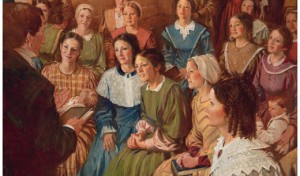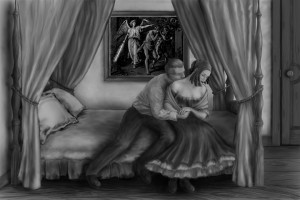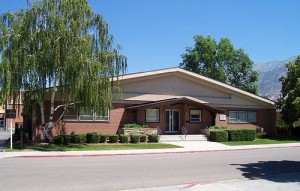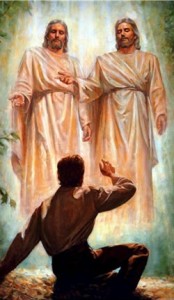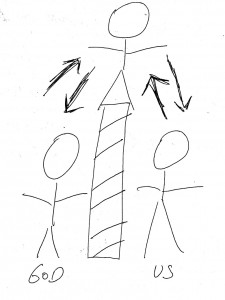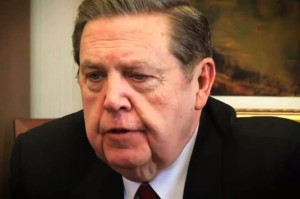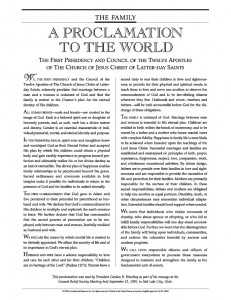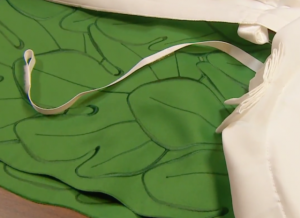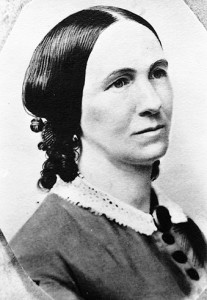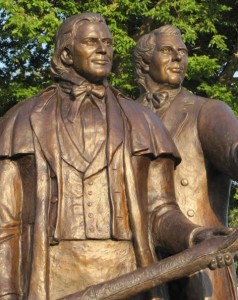 In October (2014) Mormon blogger Jana Riess wrote about the “shadow side” of Mormonism: the “tendency to idolize – as in actually make idols of – the men who run our church. An idol is anything we use as a substitute for God,” Dr. Riess wrote, “and I feel that sometimes, we cross that line in Mormon culture.”
In October (2014) Mormon blogger Jana Riess wrote about the “shadow side” of Mormonism: the “tendency to idolize – as in actually make idols of – the men who run our church. An idol is anything we use as a substitute for God,” Dr. Riess wrote, “and I feel that sometimes, we cross that line in Mormon culture.”
Citing the beloved Mormon hymn, “Praise to the Man,” that idolizes Joseph Smith as an intercessor for people in heaven, Dr. Riess admonished, “That is not okay.” Referencing Terryl and Fiona Givens’ book, The Crucible of Doubt, she explained that the Givenses
“beautifully get to the heart of one of the greater dangers of idolatry, that we will surrender our own agency and growth. We are so very eager to avoid making decisions ourselves: ‘too often, we confuse the call to discipleship with the desire to unload responsibility for our spiritual direction onto another. Christ invites us to assume the yoke, but we would rather ride in the cart.’ (p 62)”
Some years ago former Mormon Kathleen Baldwin wrote about what she, as a Christian, missed about being a member of the Mormon Church. This element of Mormon life – that of having someone make decisions for her – figured prominently in her sense of loss. Because Kathleen’s reflections on transitioning from Mormonism to Christianity are filled with valuable insight, I offer them here.
What I Miss About Being a Mormon
by Kathleen Baldwin
This ministry exists to alert people to the spiritually damaging teachings of the LDS Church and hopefully steer them toward saving grace. However, I think it behooves us to take a moment to reflect on the reasons why a Mormon wants to stay Mormon. Sometimes we stand outside and scratch our heads wondering why they won’t listen, why they won’t awaken to the truth, why they don’t rebel against the strictures of their man-made religion? The Mormon Church is compelling. If it weren’t, it wouldn’t present much of a threat. Today I’m going to confess to you some of the things I sincerely miss about my life as an entrenched Mormon.
First and foremost, I miss the sense of belonging. No matter what city I moved to or what part of the country I visited, I knew I would have a branch or ward of the Mormon Church waiting to welcome me with open arms. Instant friends. Friendship is compelling.
You might wonder what sort of friends they were, if they would be so instantly accepting? Good friends. Let me explain why. Mormons work very hard. The women, in particular, work extremely hard. When I told my sister that I was leaving the Mormon Church to become a Born-Again Christian, she smacked her hand angrily against the steering wheel and shouted at me, “I feel like you’re abandoning me! Leaving me to work all by myself.”
She was right. I abandoned the Mormon struggle to achieve perfection. I accepted grace and left the impossible work to Jesus Christ.
Common struggle is a powerful binding force. Mormon women labor together in Relief Society, Visiting Teaching, Primary, genealogy, Church Welfare Farms, Mutual, Sunday school. They commiserate with one another in their struggle to achieve perfection within their families and in themselves. They labor under this impossible load together. They lament their failures together. Weep together. Celebrate their triumphs together. These common battles bind them together. Look at the cohesiveness of other support groups: cancer patients, children of alcoholics, Mothers Against Drunk Driving. Mormons feel like they are fighting a war together, just like the soldiers in Band of Brothers. Pulling together in this overwhelming struggle creates a nearly unbreakable bond; one that is very hard to leave.
I also miss not having to think so hard. Don’t laugh. It’s true. Now that I am a Christian I must think about everything, discern right from wrong on an hourly basis. Whew! There is something to be said for being told exactly what to do. The Mormon Church dictated everything, from the length of my skirt to what I ought to eat and drink, whether my child could go to a slumber party, or date before age sixteen. Rules placate us. Rules take away the need for exercising thought, or discernment. Ah, but God, He wants us to think, expects us to consult with Him, mull it over, evaluate the situation, consider the individuals involved. It’s much easier to be told exactly what’s expected.
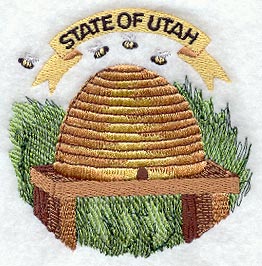 The LDS Church had a master plan for their members’ lives, everything planned to keep them busy, busy, busy, until the grave. It’s no accident that they chose the symbol of the beehive for the Utah state logo; industrious folks, Mormons. Boys go on missions at [eighteen], come back, go to school, marry, obtain productive and lucrative jobs, raise as many children as possible, convert friends, serve as leaders in local wards, work, work, work.
The LDS Church had a master plan for their members’ lives, everything planned to keep them busy, busy, busy, until the grave. It’s no accident that they chose the symbol of the beehive for the Utah state logo; industrious folks, Mormons. Boys go on missions at [eighteen], come back, go to school, marry, obtain productive and lucrative jobs, raise as many children as possible, convert friends, serve as leaders in local wards, work, work, work.
One thing that terrified me when leaving Mormonism might surprise you. Funerals. If someone in my family died, I worried, how I would know what to do? I’d done funerals the Mormon way all my life. I knew exactly how to proceed as a Mormon, but how did other people do it? In the Mormon Church, every ritual has a format that the members are accustomed to. Weddings, births, baptisms and funerals are all handled a certain way. There is comfort in knowing exactly how these big stressful life-passage moments will be conducted. As a Christian, I’ll be winging it.
Speaking of master plans, did you know every Mormon meeting format is the same in New York as it is in Arizona? Yep, everything is conducted uniformly. Even the Church buildings are laid out exactly the same. A ward building in California will have the same layout as a ward building in Maine. There’s comfort in familiarity. You know where the restrooms are without asking.
Elements such as these create confidence in the Mormon Church organization. This produces security. A Mormon has faith in the “Church” rather than in Jesus Christ. This is known as collective faith. The Mormon believes her church is leading her to heaven. She does not have to worry about her personal faith as much. As long as she has confidence that the LDS Church is guiding her correctly, all she has to do is obey. This reduces her need for developing a trusting relationship with God. Her primary trust is in the Church. It’s much easier to trust the tangible than the intangible.
As a Christian, I feel like the lonely pilgrim in The Pilgrim’s Progress. My journey is my own. Sure, I meet friends and have some companionship along the way, but it is largely a journey I make alone. And so it is for every Christian. My relationship with God is unique–individual–as is yours. It does not take the shape of a carefully outlined, step-by-step, pre-organized plan. God plans it. Our Father in Heaven has a unique relationship development plan for every believer, just as you have a unique plan for relationship with each of your children, your friends and family.
God is in control of our relationship. The Christian faces the choice of responding to God or not responding. This connection with God becomes a living breathing reality between Father and child. No longer is it a function of performing certain universal tasks to fulfill the requirements laid out by church leaders and thereby appease the Heavenly taskmaster.
Our life’s adventure does not consist of predictable certainties laid out for us by church leaders. It is a walk we take by faith. Predictability, fitting a mold, adhering to a list of rules–these things do not require much faith.
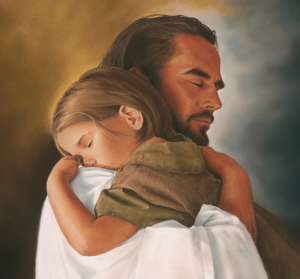 When I became a Christian, I traded earthly security to keep my eyes on Jesus. And, just like Peter when he tried to walk on water, this requires steadfast faith or I begin to sink. Real relationship ain’t pretty. Those who stay in the boat feel far more secure, and they have the luxury of smugness. They don’t get wet. Jesus doesn’t scold them, saying, “Oh ye of little faith.” No, they remain unchastised, snug and safe on the boat.
When I became a Christian, I traded earthly security to keep my eyes on Jesus. And, just like Peter when he tried to walk on water, this requires steadfast faith or I begin to sink. Real relationship ain’t pretty. Those who stay in the boat feel far more secure, and they have the luxury of smugness. They don’t get wet. Jesus doesn’t scold them, saying, “Oh ye of little faith.” No, they remain unchastised, snug and safe on the boat.
Mormons keep their eyes on an earthly man, a “prophet,” a flesh and blood guy they see twice a year at their General Conference. They rely on him to get the latest scoop from God. As a Mormon, I thought all I had to do was listen and obey, and then I’d be all right eternally. Now that’s security. Too bad, it isn’t real security.
Safety is compelling. If safety is of foremost importance to your Mormon friend, she will stay on the boat. She will sit tight and listen to the man she thinks is a prophet. She won’t get sloshed with grimy seawater trying to do something crazy like walk on water. Me, I’m willing to risk it. I’ve got the Son of God out there with me.
Yes, I miss many things about being Mormon, the comradeship of my struggling friends, the sense of security (albeit false), the comfort of sameness and familiar rituals. But there isn’t enough security or comfort in the world to make me re-strap that impossible burden on my back. No earthly friendship could compel me to give up the satisfying relationship I have with my Creator and Savior. Nothing in this world could make me go back to being a slave to the law now that I have been adopted by grace into the freedom of Christ’s family.
—
Kathleen’s article was originally published in A Word in Season, Winter 2004.

